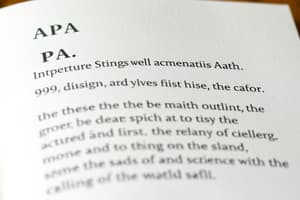Podcast
Questions and Answers
The ______ of the publication of the source is important for citation.
The ______ of the publication of the source is important for citation.
date
Citations can be arranged in ______ order based on the year of publication.
Citations can be arranged in ______ order based on the year of publication.
chronological
One of the citation styles is the American Psychological ______ (APA).
One of the citation styles is the American Psychological ______ (APA).
Association
When citing by ______, you discuss all your data and information from sources separately.
When citing by ______, you discuss all your data and information from sources separately.
In citing works with three or more authors, the citation should include all of the ______.
In citing works with three or more authors, the citation should include all of the ______.
The ______ Manual of Style (CMS) is another widely used citation format.
The ______ Manual of Style (CMS) is another widely used citation format.
Citing sources ______ involves noting when the information was published.
Citing sources ______ involves noting when the information was published.
The ______ of publishing is also a crucial part of citation information.
The ______ of publishing is also a crucial part of citation information.
You should use a hanging ______.
You should use a hanging ______.
The author's last name must come ______ before the given name.
The author's last name must come ______ before the given name.
The first word of the ______ must be capitalized.
The first word of the ______ must be capitalized.
In an online news article citation, you must include the ______ of publication.
In an online news article citation, you must include the ______ of publication.
Argument synthesis enables a researcher to present his/her point of ______ from a certain topic.
Argument synthesis enables a researcher to present his/her point of ______ from a certain topic.
According to the Divine Creation Theory, the world was created by the ______.
According to the Divine Creation Theory, the world was created by the ______.
When there are two or more authors, ______ must be used to separate them.
When there are two or more authors, ______ must be used to separate them.
Example: Dela Cruz, A.N.(2019).The big bang theory ______.
Example: Dela Cruz, A.N.(2019).The big bang theory ______.
Citing sources with two authors in APA style requires the authors' ______ and the year of publication.
Citing sources with two authors in APA style requires the authors' ______ and the year of publication.
In by topic citations, the word 'and' is replaced by the symbol ______.
In by topic citations, the word 'and' is replaced by the symbol ______.
According to the APA style, when citing works with three to five authors, you can shorten the citation by using ______ to indicate additional authors.
According to the APA style, when citing works with three to five authors, you can shorten the citation by using ______ to indicate additional authors.
In indirect citations, the primary author's last name, year of publication, and page number are separated by ______.
In indirect citations, the primary author's last name, year of publication, and page number are separated by ______.
The ______ list in APA style is commonly found at the end of the paper.
The ______ list in APA style is commonly found at the end of the paper.
APA format requires that all references in the bibliography section are listed ______ according to their surnames.
APA format requires that all references in the bibliography section are listed ______ according to their surnames.
In APA style, when citing multiple authors by author, the containing citation includes their full ______.
In APA style, when citing multiple authors by author, the containing citation includes their full ______.
In a by topic citation, authors’ surnames must be accompanied by the year of ______.
In a by topic citation, authors’ surnames must be accompanied by the year of ______.
The Theory of Evolution by Natural Selection was published by ______.
The Theory of Evolution by Natural Selection was published by ______.
Sources of information can be categorized into four types: documents, numerical records, oral statements, and ______.
Sources of information can be categorized into four types: documents, numerical records, oral statements, and ______.
The simplest way of organizing a synthesis is through a ______.
The simplest way of organizing a synthesis is through a ______.
One technique for synthesizing information involves providing an example or ______.
One technique for synthesizing information involves providing an example or ______.
The introduction of your review of related literature is typically composed of a single ______.
The introduction of your review of related literature is typically composed of a single ______.
The body of a review of related literature presents all the relevant ______ that you have gathered.
The body of a review of related literature presents all the relevant ______ that you have gathered.
The technique of showing the similarities and differences of two or more data is known as ______ and contrast.
The technique of showing the similarities and differences of two or more data is known as ______ and contrast.
One type of source includes numerical data in written form, called ______ records.
One type of source includes numerical data in written form, called ______ records.
A researcher must maintain his/her ______.
A researcher must maintain his/her ______.
Researchers must abide by the legalities, rules, policies, and ______ set by their partner institution.
Researchers must abide by the legalities, rules, policies, and ______ set by their partner institution.
Ethical ______ refers to values that are translated into rules or standards of conduct.
Ethical ______ refers to values that are translated into rules or standards of conduct.
An ______ is a situation where there is a conflict between values and principles.
An ______ is a situation where there is a conflict between values and principles.
Fabrication and falsification of data is also known as ______.
Fabrication and falsification of data is also known as ______.
Non-publication of data occurs when researchers choose not to include data because it does not conform to established ______.
Non-publication of data occurs when researchers choose not to include data because it does not conform to established ______.
Plagiarism is a fraudulent act that involves claiming another person’s ______, work, or publication.
Plagiarism is a fraudulent act that involves claiming another person’s ______, work, or publication.
Faulty data gathering procedures can result from negligence or ______ that leads to errors.
Faulty data gathering procedures can result from negligence or ______ that leads to errors.
Copy and paste plagiarism involves copying information -by- without giving due credit.
Copy and paste plagiarism involves copying information -by- without giving due credit.
Mosaic plagiarism is characterized by changing only some ______ in the copied information.
Mosaic plagiarism is characterized by changing only some ______ in the copied information.
Self-plagiarism can occur when an author republishes his/her ______.
Self-plagiarism can occur when an author republishes his/her ______.
In a literature review, ______ must be observed and respect for others' works should be exercised.
In a literature review, ______ must be observed and respect for others' works should be exercised.
A good literature review must be ______ to the research topic.
A good literature review must be ______ to the research topic.
Ideas in a literature review must be presented ______.
Ideas in a literature review must be presented ______.
The literature review should flow ______ and logically connect ideas.
The literature review should flow ______ and logically connect ideas.
Researchers must ensure that they use only ______ information in their literature reviews.
Researchers must ensure that they use only ______ information in their literature reviews.
Flashcards
By Author Citation
By Author Citation
Citation method where the information is attributed to the author directly, individually mentioning their last name and publication year.
By Topic Citation
By Topic Citation
Citation method where multiple sources mentioning the same information about a specific topic are acknowledged together.
Chronological Citation
Chronological Citation
Citation method where sources are organized by their publication year, from earliest to latest, showing the evolution of knowledge.
American Psychological Association (APA) Citation Style
American Psychological Association (APA) Citation Style
Signup and view all the flashcards
In-Text Citation (APA)
In-Text Citation (APA)
Signup and view all the flashcards
APA Citation for One Author
APA Citation for One Author
Signup and view all the flashcards
Citation
Citation
Signup and view all the flashcards
Plagiarism
Plagiarism
Signup and view all the flashcards
Documents
Documents
Signup and view all the flashcards
Numerical Records
Numerical Records
Signup and view all the flashcards
Oral Statements
Oral Statements
Signup and view all the flashcards
Relics
Relics
Signup and view all the flashcards
Summary
Summary
Signup and view all the flashcards
Example or Illustration
Example or Illustration
Signup and view all the flashcards
Two (or more) Reasons
Two (or more) Reasons
Signup and view all the flashcards
Comparison and Contrast
Comparison and Contrast
Signup and view all the flashcards
Hanging Indentation (APA)
Hanging Indentation (APA)
Signup and view all the flashcards
Author Name Format (APA)
Author Name Format (APA)
Signup and view all the flashcards
Synthesis
Synthesis
Signup and view all the flashcards
Explanatory Synthesis
Explanatory Synthesis
Signup and view all the flashcards
Argument Synthesis
Argument Synthesis
Signup and view all the flashcards
Divine Creation Theory
Divine Creation Theory
Signup and view all the flashcards
The Big Bang Theory
The Big Bang Theory
Signup and view all the flashcards
APA Format
APA Format
Signup and view all the flashcards
APA Citation: Two Authors
APA Citation: Two Authors
Signup and view all the flashcards
APA Citation: 3-5 Authors
APA Citation: 3-5 Authors
Signup and view all the flashcards
APA Citation: Shortening with 'et al.'
APA Citation: Shortening with 'et al.'
Signup and view all the flashcards
APA Citation: Indirect Source
APA Citation: Indirect Source
Signup and view all the flashcards
APA Referencing List
APA Referencing List
Signup and view all the flashcards
APA Referencing List Order
APA Referencing List Order
Signup and view all the flashcards
APA Referencing List Details
APA Referencing List Details
Signup and view all the flashcards
APA Referencing Style
APA Referencing Style
Signup and view all the flashcards
Ethical Relativism
Ethical Relativism
Signup and view all the flashcards
Ethical Principles
Ethical Principles
Signup and view all the flashcards
Ethical Dilemma
Ethical Dilemma
Signup and view all the flashcards
Fabrication and Falsification of Data
Fabrication and Falsification of Data
Signup and view all the flashcards
Non-Publication of Data
Non-Publication of Data
Signup and view all the flashcards
Faulty Data Gathering Procedures
Faulty Data Gathering Procedures
Signup and view all the flashcards
Social and Legal Responsibility
Social and Legal Responsibility
Signup and view all the flashcards
Copy and Paste Plagiarism
Copy and Paste Plagiarism
Signup and view all the flashcards
Mosaic Plagiarism
Mosaic Plagiarism
Signup and view all the flashcards
Misattribution Plagiarism
Misattribution Plagiarism
Signup and view all the flashcards
Self-Plagiarism
Self-Plagiarism
Signup and view all the flashcards
Literature Review (RRL)
Literature Review (RRL)
Signup and view all the flashcards
Characteristics of a Good Literature Review
Characteristics of a Good Literature Review
Signup and view all the flashcards
Focus in a Literature Review
Focus in a Literature Review
Signup and view all the flashcards
Study Notes
Research Study Objectives
- Students will define terms related to research studies
- Students will gather and synthesize information from diverse sources
- Students will be familiarized with different citation styles and formats
- Students will understand the characteristics and mechanisms of reviewing related literature
- Students will learn to correctly cite sources used in research
- Students will appreciate the importance of ethical standards in research source use
Research Overview
- Research is systematic inquiry involving data collection, documentation of information, and analysis/interpretation via methodologies specific to disciplines
- Primary sources detail research findings (e.g., journals)
- Secondary sources summarize another author's work (e.g., textbooks, encyclopedias)
Citation of Related Literature
- Proper citations prevent authenticity issues in published papers
- Citations inform readers about borrowed information, clarifying its source and context
- Citations take two forms: in-text citations and a reference list
In-Text Citations
- In-text citations appear within research chapters
- Include the author's name, publication date, and page number
Referencing Lists
- Referencing lists are a complete record of all sources
- Include author's name, date of publication, page number, publisher, publication location, volume, edition, and other relevant information
In-Text Citation Guidelines
- Citations can be organized by author, topic, or chronologically
- Author method: Separate discussion of each author's ideas
- Topic method: Group works with identical points on a topic
- Chronological method: Order sources by publication date
Synthesis of Information
- Synthesis combines information from multiple sources
- Explanatory synthesis: Presents information objectively
- Argument synthesis: Presents a viewpoint or argument
Review of Related Literature
- RRLs typically have three sections: Introduction, Body, and Conclusion
- Introduction summarizes the general research topic
- Body presents gathered information logically; considers objectives and themes
- Conclusion provides an overall summary of the topic's knowledge base; highlights research significance
Literature Review Guidelines
- Define the topic and audience
- Search and research reference materials
- Create a conceptual diagram of different types of literature review
- Take detailed notes while reading
- Select a desired review type
- Maintain a focused and broadly interesting review
- Be critical and consistent
- Employ a logical structure
- Consult and incorporate feedback
Research Ethics
- Research ethics establish acceptable conduct
- Eight key principles guide ethical conduct:
- Honesty (transparency, accurate citation of sources)
- Objectivity (avoiding bias)
- Integrity (sincerity, consistency)
- Carefulness (avoiding negligence and errors)
- Openness (accepting feedback, handling criticism constructably)
- Respecting intellectual property (properly citing sources, acknowledging ownership)
- Trustworthiness (protecting data integrity, maintaining confidentiality)
- Social & legal responsibility (adhering to institutional policies and laws)
- Scientific misconduct involves unethical research practices (e.g., fabrication, falsification, non-publication of data, faulty data gathering procedures, plagiarism)
Categories of Sources
- Four main categories of information sources
- Documents (written materials: books, articles, reports)
- Numerical records (census data, reports, financial statements)
- Oral statements (stories, legends, personal accounts)
- Relics (physical objects, artifacts)
Techniques for Writing a Synthesis
- Summary: The simplest approach; organizes information coherently based on source material
- Illustration/example: Uses concrete examples related to a topic
- Reasons: Thesis development with supporting reasons for the thesis
- Comparison and Contrast: Examines similarities and differences between topics or data
Presenting a Written Literature Review
- Structure depends on research topic and area
- Must observe objectivity and respect for others' work
- Features of a strong literature review include:
- Focused; addressing the research topic directly
- Concise; presenting essential information effectively
- Logical; maintaining a clear flow of information
- Comprehensive; including relevant and thorough information
- Integrative; showing connections between ideas
- Current; using recent and relevant information
Studying That Suits You
Use AI to generate personalized quizzes and flashcards to suit your learning preferences.




